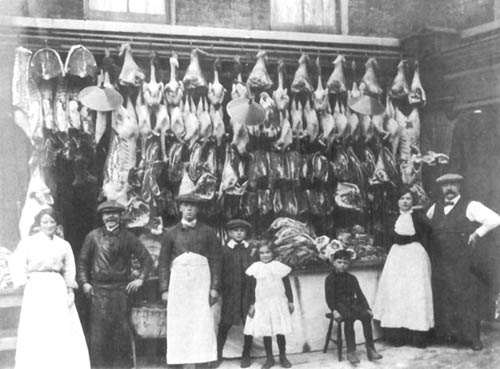
1. The Whitechapel hay market, 1899. A legacy from the eighteenth century which continued until 1928.
2. The Waller family outside their butcher’s shop in Watney Street, c. 1910, with a display guaranteed to horrify today’s ‘food police’.
3. Evans’s dairy in Poplar High Street, c. 1928, offering a typically wide range of provisions with some almost forgotten brand names.
4. A view of the ‘LaBo’, the La Bohème cinema, c. 1931, at the junction of Mile End Road and Burdett Road, viewed from Grove Road, where I lived (at number 109) as a child.
5. Abraham Cohen’s barbers, Ellen Street, Stepney, c. 1930. Small businesses such as Mr Cohen’s once provided an important focus for local communities.
6. George Gardens, Bethnal Green, 1903. A terrace of houses with the ‘luxury’ of having somewhere to hang out the washing.
7. Drying racks in the Sophia Street laundry, 1931. With few of today’s labour-saving devices, public wash houses were a boon.
8. Victorian dustmen. Refuse collection using a tip-up cart in Old Montague Street, c. 1895.
9. The drudgery of ill-paid homework, c. 1900. Mrs Robinson of Bethnal Green stuffs a palliasse with straw; for each completed mattress she was paid the equivalent of 5p.
10. Child victims of poverty in the East End. Members of a family of nine photographed in July 1912.
11. My father, Tom (circled), aged five, in 1924, with the rest of Mrs Chalkley’s form at Alton Street School, Poplar.
12. Making their own fun. Children enjoying a game of leap-frog, 1905.
13. Using the tin bath as a makeshift paddling pool in the backyard of 109 Grove Road. I am in the middle, with my brother Tony on my right and one of his friends, c. 1954.
14. Celebrating peace by ‘slipping the slip’ at the English Fair, Poplar recreation ground, 1919.
15. The children’s ward in Poplar Hospital, 1906.
16. Poplar High Street, c. 1900. The labouring poor, the elderly and the infirm dreaded having to go into the workhouse.
17. Victoria Park, 1908. A place of both leisure and public protest, ‘Vicky’ has witnessed, over the years, the building and demolition of its glorious 1920s lido, gatherings of demonstrators ranging from Chartists to Blackshirts, and local people simply enjoying its many pleasures.
18. A family day out. Front row from left, ‘Old Mrs Cooper’ with baby Harry and son Percy; next seated, Maggie Cooper (Jamie Redknapp’s great-grandmother) with daughter; standing, my grandmother Bridget Knight, pregnant with my dad, with daughter Sally, and the driver (Mrs Cooper’s eldest son). Back row from left, Mrs Cooper’s brother, Gerry Brown (Jamie Redknapp’s great-grandfather), and William Griffiths, my grandfather.
19. Above Posing, 1934-style, at Poplar Baths.
20. Right The Russian vapour baths at 86 Brick Lane, c. 1910. Being opposite the Great Synagogue, they were very popular with the local orthodox Jewish community.
21. Bethnal Green, 1904. Following the Huguenot tradition of songbird and pigeon fancying, the Club Row and Sclater Street Sunday bird market was always packed. Wild birds, particularly goldfinches, which had been trapped in the Essex countryside, were sold illegally.
22. In the 1920s the Nastri family of Railway Street, Poplar, also sold ice-cream and ice, like the family shown here. They used a truck to tour the streets and in winter transferred their interests to the coal and coke business.
23. ‘Chinatown’: Pennyfields, Limehouse, 1927.
24. A different world: before the docks became Docklands. Dunbar’s Wharf, Narrow Street, c. 1900.
25. A ‘dock copper’ checking that a dock worker isn’t leaving with more than he arrived with.
26. The Royal Artillery unloading a ship during a dockworkers’ strike in July 1949 at the Royal Albert Dock.
27. London Docks, 1961. Built at Wapping in 1805, they handled much of the valuable tobacco, wine and brandy imports.
28. Royal Docks, 1942. Despite the bombing and the danger, vital food imports still had to be unloaded.
29. Sheltering from the bombs for the night became a part of wartime family life.
30. The docks, vital to the life of the country, were continually targeted by enemy bombers.
31. Royal Docks, 1944. Admiring a consignment of canned meat from the United States during the hard days of rationing and shortages.
32. ‘Bombed out’: Lydia Street, 1940. Moving whatever could be salvaged from the wreckage.
33. VE Day celebrations, 8 May 1945. After nearly six long years, the East End was readv to celebrate.
34. Women enjoying a chat in Whitechapel, 1938. Note the ‘uniform’ of cross-over aprons and hairnets.
35. Teatime, Whitechapel, 1938. Having a professional photographer in the home meant a nice cloth and the best china would be brought out.
36. Scrubbing the step ready for the Coronation party, 1953. Beware anyone foolish enough to actually put a foot on a freshly scrubbed step.
37. Like most other turnings in the East End, Morpeth Street held a weekly collection to pay for the food and Coronation souvenir china for their street party, June 1953.
38. Attracting the punters, Petticoat Lane, 1936.
39. Attracting the punters, Petticoat Lane, 1998.
40. Likely lads, 1951, by an advertisement for the ever-popular Troxy.
41. celebration ‘kneesup’ at Bill Cannon’s ‘pigeon do’, 1960s. My mother, Dolly, is on the right, and next to her is my aunt Doll.
42. Using a length of rope, a lamppost and their imagination, two girls, without benefit of expensive toys, delight in their shared game, c. 1950.